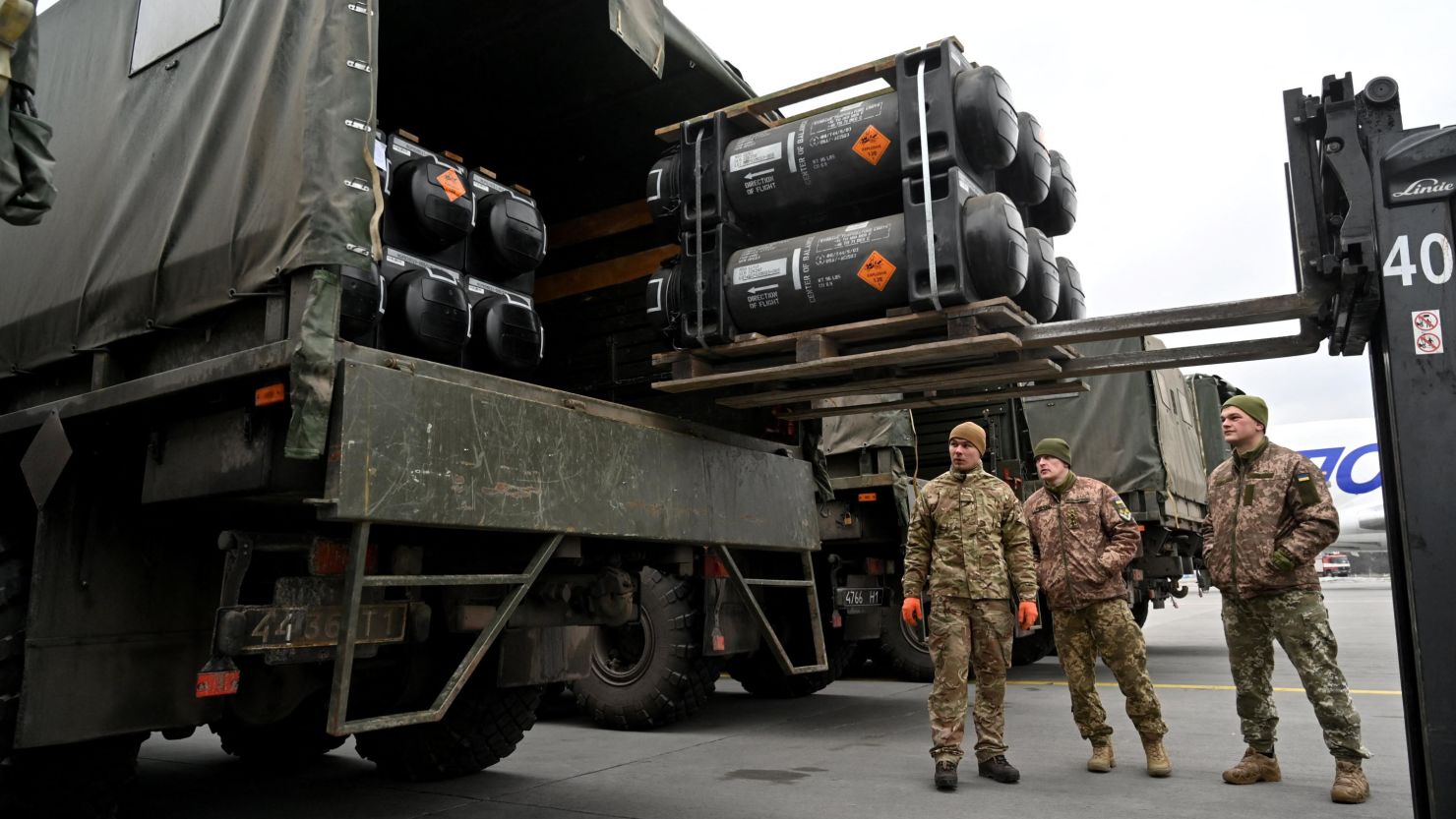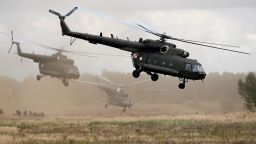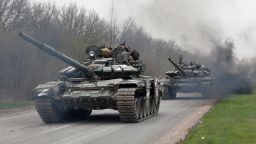The US has few ways to track the substantial supply of anti-tank, anti-aircraft and other weaponry it has sent across the border into Ukraine, sources tell CNN, a blind spot that’s due in large part to the lack of US boots on the ground in the country – and the easy portability of many of the smaller systems now pouring across the border.
It’s a conscious risk the Biden administration is willing to take.
In the short term, the US sees the transfer of hundreds of millions of dollars’ worth of equipment to be vital to the Ukrainians’ ability to hold off Moscow’s invasion. A senior defense official said Tuesday that it is “certainly the largest recent supply to a partner country in a conflict.” But the risk, both current US officials and defense analysts say, is that in the long term, some of those weapons may wind up in the hands of other militaries and militias that the US did not intend to arm.
“We have fidelity for a short time, but when it enters the fog of war, we have almost zero,” said one source briefed on US intelligence. “It drops into a big black hole, and you have almost no sense of it at all after a short period of time.”
In making the decision to send billions of dollars of weapons and equipment into Ukraine, the Biden administration factored in the risk that some of the shipments may ultimately end up in unexpected places, a defense official said.
But right now, the official said, the administration views a failure to adequately arm Ukraine as a greater risk.
Because the US military is not on the ground, the US and NATO are heavily reliant on information provided by Ukraine’s government. Privately, officials recognize that Ukraine has an incentive to give only information that will bolster their case for more aid, more arms and more diplomatic assistance.
“It’s a war – everything they do and say publicly is designed to help them win the war. Every public statement is an information operation, every interview, every Zelensky appearance broadcast is an information operation,” said another source familiar with western intelligence. “It doesn’t mean they’re wrong to do it in any way.”
For months, US and western officials have offered detailed accounts about what the West knows about the status of Russian forces inside Ukraine: how many casualties they’ve taken, their remaining combat power, their weapons stocks, what kinds of munitions they are using and where.
But when it comes to Ukrainian forces, officials acknowledge that the West – including the US – has some information gaps.
Western estimates of Ukrainian casualties are also foggy, according to two sources familiar with US and western intelligence.
“It’s hard to track with nobody on the ground,” said one source familiar with the intelligence.
Visibility Questions
The Biden administration and NATO countries say they are providing weapons to Ukraine based on what the Ukrainian forces say they need, whether it’s portable systems like Javelin and Stinger missiles or the Slovakian S-300 air defense system that was sent over the last week.
Javelin and Stinger missiles and rifles and ammunition are naturally harder to track than larger systems like the S-300, which was shipped by rail. Although Javelins have serial numbers, there is little way to track their transfer and use in real time, sources familiar with the matter say.
Last week the US agreed to provide Kyiv with the types of high-power capabilities some Biden administration officials viewed as too much of an escalation risk a few short weeks ago, including 11 Mi-17 helicopters, 18 155 mm Howitzer cannons and 300 more Switchblade drones. But much of that support hasn’t yet come online — and the Switchblades are mobile, one-time use drones that would also likely be difficult to track after the fact.
“I couldn’t tell you where they are in Ukraine and whether the Ukrainians are using them at this point,” a senior defense official told reporters last week. “They’re not telling us every round of ammunition they’re firing and who and at when. We may never know exactly to what degree they’ve using the Switchblades.”
The Defense Department doesn’t earmark the weapons it sends for particular units, according to Pentagon press secretary John Kirby.
Trucks loaded with pallets of arms provided by the Defense Department are picked up by Ukrainian armed forces – primarily in Poland – and then driven into Ukraine, Kirby said, “then it’s up to the Ukrainians to determine where they go and how they’re allocated inside their country.”
A congressional source pointed out that while the US is not on the ground in Ukraine, the US has tools to learn what’s happening beyond what the Ukrainians are saying, noting the US has extensive use of satellite imagery and both the Ukrainian and Russian militaries appear to be using commercial communications equipment.
Another congressional source said the US military’s views the information it’s receiving from Ukraine as generally reliable because the US has trained and equipped the Ukrainian military for eight years now, developing strong relationships. But that doesn’t mean there aren’t some blind spots, the source said, such as on issues like the operational status of Ukraine’s S-300s.
Jordan Cohen, a defense and foreign policy analyst at the CATO institute who focuses on arms sales, said the biggest danger surrounding the flood of weapons being funneled into Ukraine is what happens to them when the war ends or transitions into some kind of protracted stalemate.
Such a risk is part of any consideration to send weapons overseas. For decades, the US sent arms into Afghanistan, first to arm the mujahideen in their fight against the Soviet army, then to arm Afghan forces in their fight against the Taliban.
Inevitably, some weapons ended up on the black market including anti-aircraft Stinger missiles, the same kind the US is now providing to Ukraine.
The United States famously scrambled to recover Stingers after the Soviet war in Afghanistan. It wasn’t successful in finding all of them and when the US itself invaded Afghanistan in 2001, some officials feared that they could be used by the Taliban against the United States.
Other weapons have ended up arming US adversaries. Much of what the US left behind to help Afghan forces became part of the Taliban arsenal after the collapse of the Afghan government and military.
The problem is not unique to Afghanistan. Weapons sold to Saudi Arabia and the United Arab Emirates found their way into the hands of fighters linked to al-Qaeda and Iran.
The risk of a similar scenario happening in Ukraine also exists, the defense official acknowledged. In 2020, the Defense Department inspector general released a report raising concerns about the end-use monitoring of weapons being sent to Ukraine.
But given the nearly insatiable short-term needs of Ukrainian forces for more arms and ammunition, the long-term risk of weapons ending up on the black market or in the wrong hands was deemed acceptable, the official said.
“This could be a problem 10 years down the line, but that doesn’t mean it shouldn’t be something we’re thinking about,” Cohen, the CATO analyst, said. “Over 50 million rounds of ammunition – all that ammunition isn’t just going to be used to fight Russians. Eventually that ammunition is going to be misused, whether intentionally or not.”
The Russian Threat
Officials are less concerned – at least for now – that the weapons will fall into the hands of the Russians. The source briefed on the intelligence noted that Russia’s failure to hold large swaths of territory or force the surrender of many Ukrainian units means that those arms have either been used or remain Ukrainian hands.
And so far, it appears that Russia has struggled to intercept or destroy the supply shipments. A third source familiar with the intelligence said that it does not appear that Russia has been actively attacking western weapons shipments entering Ukraine – although it is unclear exactly why, especially since the US has intelligence that the Russians want to and have discussed doing so both publicly and privately.
There are a number of theories for why the shipments have so far been spared, this person added, including that Russian forces simply can’t find them – the weapons and equipment are being sent over in unmarked vehicles and often transported at night. It could also be that the Russian forces are running out of munitions and don’t want to waste them targeting random trucks unless they can be certain they are part of an arms convoy.
Though on Monday Russian claimed it had destroyed a depot “near Lviv,” which held “large consignments” of weapons provided to Ukraine by the United States and European countries. CNN has not been able to verify the claim.
But broadly, Russia doesn’t have perfect intelligence visibility into Ukraine, either, this source noted, and their air capabilities over western Ukraine, where the shipments are coming in, are extremely limited because of Ukrainian air defense systems.
Publicly, the Pentagon says it has not yet seen Russian attempts to disrupt the weapons transfers or the shipments moving inside Ukraine.
“Flights are still going into trans-shipment sites in the region. And ground movement is still occurring of this material inside Ukraine. Every single day, there are the security assistance, weapons and material and support equipment that is getting into Ukrainian hands,” Kirby said Thursday.
“We’re going to keep doing that as much as we can, as fast as we can. We have not seen any Russian efforts to interdict that flow. And so we’re just going to keep doing it,” he added. “We constantly look at it every day monitor it, change it, adapt it as needed.”











